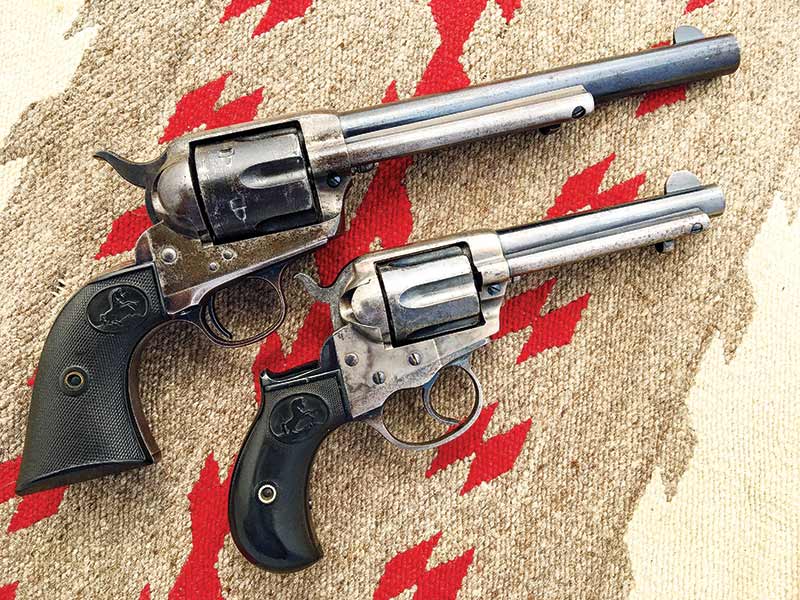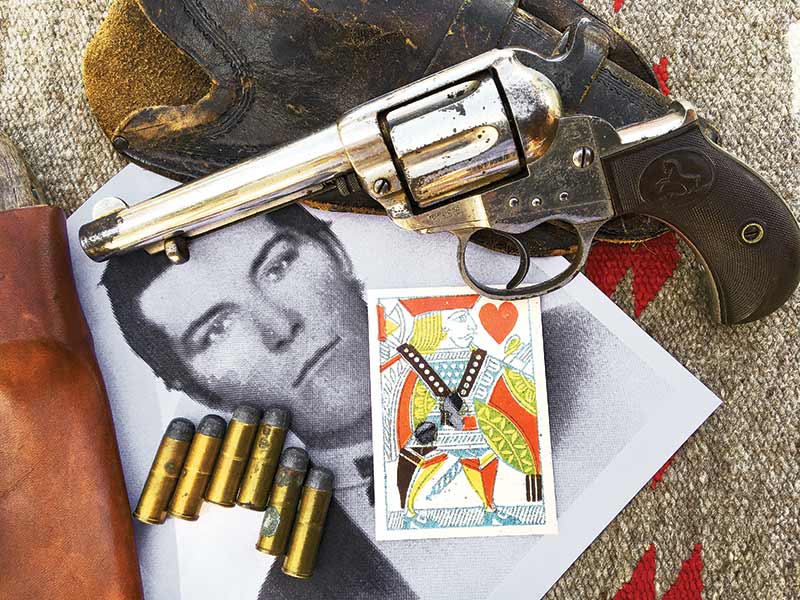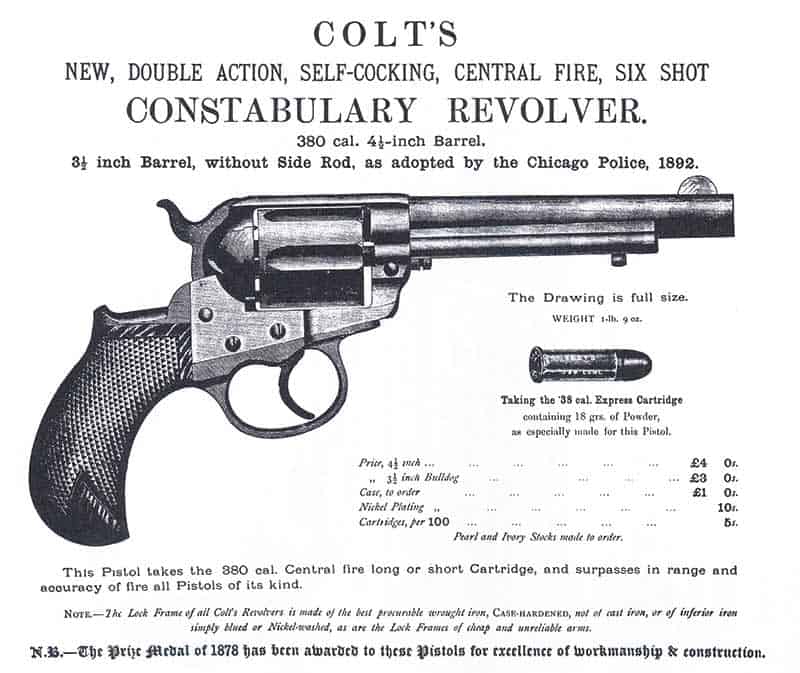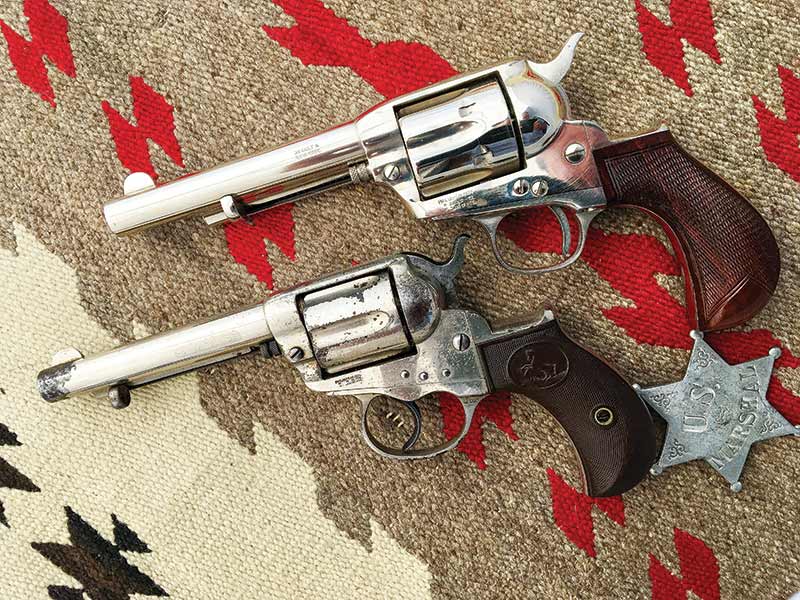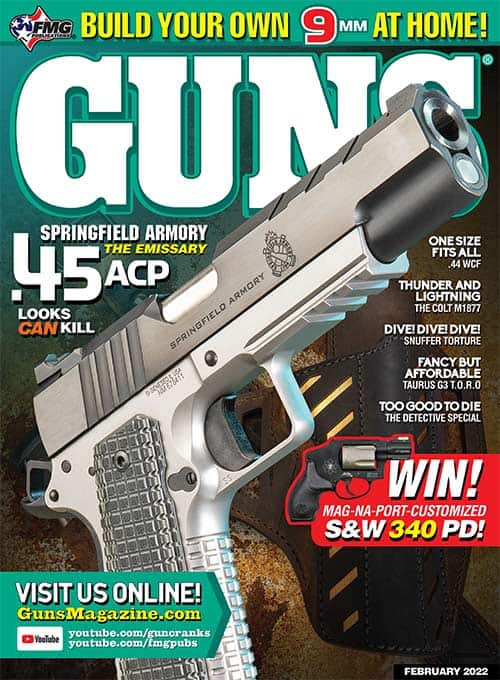Colt M1877 Revolver
The Double-Action Taking The Old West By Storm
What did Doc Holiday, Billy the Kid, Pat Garret, Pearl Hart and John Wesley Hardin have in common? They all carried Colt’s Double Action, Self-Cocking Central Fire Revolving Pistol. Catchy, isn’t it? Obviously, Colt didn’t waste money on their marketing department in 1877. If the name is too much of a tongue twister, how about we use the name Kittredge, one of Colt’s biggest distributors, called it — the Colt Lightning. The moniker was used for the .38 Colt version while The Thunderer was given to the more powerful .41 Colt version and The Rainmaker for the exceedingly rare .32 Colt version. Many collectors refer to all versions as the M1877.
Beginnings
The M1877 was a long time coming. Webley had been importing their double-action revolvers in the U.S. since roughly 1873. Still, many in the firearms industry, as well as in the military, felt rapid-fire handguns were a waste of ammunition. If it wasn’t for one man, Colt London Agency manager Frederick von Oppen, it might have been even longer before Colt plunged into the double-action market. Some historians feel this boils down to one key thing — how the U.S. Army waged war vs. how European armies waged war. In the 1870s, the focus was on westward expansion and the U.S. Army was busy fighting the indigenous tribes west of the Mississippi. With few exceptions, the battles were quick and in small numbers. Civilian and military combatants wanted the reliable precision a deliberately aimed single-action revolver provided.
The colonizing conquests of the European nations waged war differently. In many cases, the enemy was a living wall of human flesh. European officers wanted a large-caliber revolver with rapid-fire capabilities. And, in most cases, the officers were expected to provide their weapons. While the Colt Single-Action Army in .45 Colt was the weapon of choice for the U.S. Army, it was soundly rejected in London.
Oppen repeatedly asked for a large-bore double-action revolver to counter the other offerings eroding Colt’s market share in London. The management at Colt didn’t relish the idea of tooling up for an entirely new revolver design. Yes, they did win a government contract for their new single-action revolver, but even it was a leap forward from their previous open-top designs.
In desperation, Oppen sent competitors’ revolvers across the Atlantic so the Colt designers could see what they were up against in the European market. In response, Colt sent back what some think was a clumsy attempt at making the Colt SAA in double action. Oppen rejected it outright.
Ammo Problems
One of the problems was the ammunition of the day. It took a heavy hammer blow to set off the newly designed centerfire cartridge. It took an even stronger trigger finger to pull a trigger, turn the cylinder and cock a heavy hammer spring, all while maintaining a steady sight picture.
Colt turned again to the master designer of the popular Colt’s Army Revolver, which Kittredge had dubbed The Peacemaker. Years went by, but in 1877 Colt sent Oppen their new offering — it looked like a scaled-down version of the Peacemaker. The plow-handle grips had been replaced with bird’s head grips, a design which made a double-action revolver easier to grasp and shoot.
The first version was chambered in .38 Colt, an anemic cartridge compared to the heavy-hitting .45 Colt, but compared to most revolvers of the day it was a powerhouse. A .41 Colt version soon followed.
The public’s reaction was mixed. Cowboys and frontiersmen liked the simple ruggedness of the Colt Peacemaker, even if it did have to be manually cocked for each shot. But others saw the advantage of a self-cocking revolver. Outlaw turned lawyer John Wesley Hardin decided two double-action revolvers were better than one. His landlady told stories of him prancing around his room, clicking away as he practiced his shooting skills. Other stories tell of Hardin giving shooting demonstrations with playing cards and then signing them. Unfortunately for Hardin, his Colt shooting skills didn’t prevent him from being shot in the back of the head in an El Paso saloon in 1895.
The Colt M1877 gained a bad reputation as being prone to breaking and being impossible to fix. The M1877 was Colt’s first double-action, so there was a steep learning curve for their engineering department. The designers worked hard to keep the style elements of the popular Colt Single-Action Army. Still, in doing so, the lockworks were as complicated and temperamental as the Peacemaker was simple and reliable. In fact, within a year, Colt released the M1878, a newly designed, more robust double-action chambered in the .45 Colt and .44 WCF cartridge. But, for all its faults, the M1877 appealed to many shooters because of the smaller frame and grips. Women especially liked the M1877 for this very reason but many professional gunmen also relied on them
Coppers Carry
The M1877 appealed to another group as well. According to an article by firearm historian Dr. RC Marohn, metropolitan police officers were looking for a smaller-framed revolver they could keep concealed but still packed a punch. His research found many citizens in the late 1800s and early 1900s were uncomfortable with law enforcement officers carrying weapons. The shorter-barreled Lightning was the perfect blend of power and concealment. The use of the M1877 by police officers is well-documented by examples either stamped or inscribed by departments or individual officers. The 1896 Colt London catalog claimed the Chicago Police Department adopted the use of the Lightning in 1892 and advertised it as the Constabulary Revolver. But Marohn could not find evidence showing the CPD ever officially made it standard issue.
It is easy to see why the M1877 would be popular for concealment. Many were sold with a 1-1/2″ to 3-1/2″ barrel with no ejector and could easily fit in a coat pocket, boot, or even under a bustle.
The Colt M1877 had been in production for almost a quarter of a century, and Colt was offering more advanced double-action revolvers when in 1900 the production numbers spiked for several years. To some, the sudden demand for an outdated design is puzzling until they connect the dots. Pulp fiction of the Wild West was filling the heads of readers with the excitement of the vanishing frontier through the exploits of Billy the Kid, Pearl Hart, John Wesley Hardin and others who belted on the M1877. Plus, the Lightning had the look of the famous western icon, the Peacemaker.
Up To Snuff
To add to the craze, Continental Tobacco, the mega-corporation who owned a staggering amount of tobacco brands, started offering a Colt Lightning as a “present” to their patrons around 1900. Tobacco was often sold in twists and to prevent store owners from counterfeiting lesser grade leaf in place of their product, tobacco companies placed a colorful tin tag on the twist. To encourage brand loyalty, tobacco companies sent out premium catalogs with a wide range of presents that could be had free by sending in the correct amount of tags. For 1,800 tags, one would receive a genuine Colt Lightning revolver!
To understand the impact on the tobacco market, look at the numbers. From 1900-1906 Colt manufactured approximately 46,500 M1877 revolvers, and roughly 58% were chambered in .38 Colt. Of those, 12,789 were shipped out blued and sporting a 4-1/2″ barrel and an ejector. Here is the exciting part: 9,285 were purchased by Floradora, Continental and other tobacco companies. If you see a Colt Lightning with a serial number between 115500 and 160000, blued, with a 4-1/2″ barrel and ejector, there is a 78% chance it was given out as a prize by a tobacco company!
The End
In a twist, the fallible Colt 1877 outlived the revolver meant to replace it. The Colt 1878 ended production in 1905 while the spunky 1877 went on four more years.
Collectors could quickly fill a room with all of the variations sold during the M1877’s run. Barrels ran from 1-1/2″ to 10″, with and without ejectors. Grips varied from the common hard rubber to rosewood, pearl and ivory. Nickel was common as a finish, but blued examples are also readily found. Earlier models had an acid-etched panel showing the caliber on the left side of the barrel. Sadly, in many cases, the panel is worn or buffed away during refinishing. Later versions had the caliber stamped in the same location.
Finding a battered or broken M1877 isn’t hard. Finding an excellent example that hasn’t been buffed, sanded, scrubbed, or refinished is very difficult. While models are generally cheaper than an original Colt Single Action Army, the prices keep climbing. The Lightning .38 Colt version is the most common. The Thunderer .41 Colt version is a little harder to find. Only a few hundred of the Rainmaker .32 Colt versions were sold and are a prize for any collector of the M1877. In all cases, condition and originality are key-value factors. Keep in mind almost all M1877 revolvers were proofed for black powder, not modern smokeless powder.
Today
If you like the look and feel of the M1877 but don’t want to risk ruining a piece of history, there are many similar-looking revolvers out there but most are full-framed and not the more petite frame of the originals. Cimarron Firearms offers a close copy of the original M1877. In keeping with their target audience of cowboy-action shooters, and to avoid the mechanical problems of the original, the gun is single-action only. Still, the birdhead grips are perfect for shooters with smaller hands. Cimarron blends traditional and modern in their caliber offering as they come in .38 Special and the original .41 Colt.
I fully admit I am a fan of the M1877 and will rush past six tables of crisp new firearms to check out a worn Thunderer or Lightning. Their style has a refined western Americana appeal that whispers to me like a sultry lover. So, the next time you’re at a gun show and see a pearl-handled, nickel-plated, acid-etched M1877, walk right on by and leave it for me.
